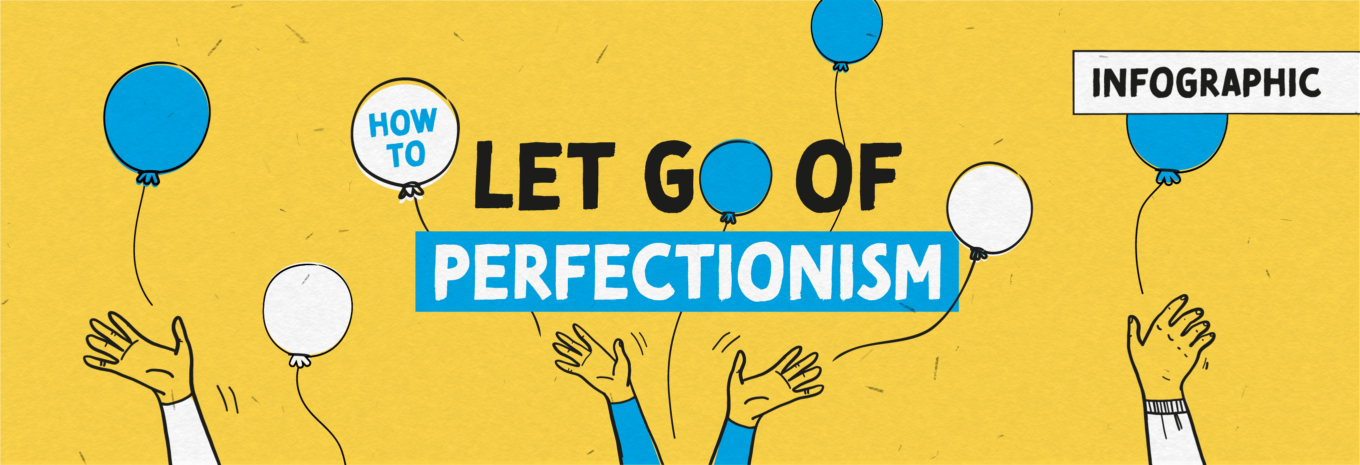How often has a friend or colleague told you to ‘stop being too hard on yourself’?
You’ve likely dished out the same advice to others – the over-thinkers, constant worriers, frequent procrastinators, imposter syndrome sufferers and perfection seekers.
Setting ourselves high standards is a good thing. But this can often lead to us being too critical of ourselves and we end up falling short of our own unreasonable expectations.
Perfectionism is becoming more prevalent. It severely undermines our emotional wellbeing, and it’s a real barrier to a good life, to a successful life and to a healthy, happy life.
In the book, Time to Breathe, Dr Bill Mitchell explains how we can learn to shape perfectionism to work in our favour and to loosen our grip on this well-protected mindset.
In our latest infographic, we look at his ten reasons not to be a perfectionist and explore some short exercises designed to change how you think for greater mental flexibility and resilience.

High standards are a good thing.
But setting ourselves unreasonable goals can trigger catastrophising thoughts and feelings of guilt, inadequacy and failure, leading to poor mental health and burnout.
Perfectionism can be a blocker to a healthy, happy and successful life.
10 reasons to let go of perfectionism:
- Perfectionists don’t give themselves permission to put themselves first
- Perfectionism is linked to depression
- Perfectionism is one of the main reasons people suffer from low self-esteem
- Perfectionists can’t relax
- Perfectionists can become pushy parents
- Perfectionists can be poor managers
- Perfectionism leads to procrastination
- Perfectionists can struggle with change
- Perfectionists can make poor leaders
- Perfectionism takes time away from other things
By loosening our grip on perfectionism, shifting our perception of control over life circumstances and defining the purpose we see in what we do, we can begin to let go of mental burdens.
Explore these exercises based on talking, rationalising and visualising to change your mindset and develop greater mental flexibility:
- Develop the challenge mindset – Visualise the challenge, your surroundings and the people you are engaging with. Picture yourself doing it well. Maintain this image for 20 seconds while you relax. Note three qualities you have that could allow you to succeed.
- See platforms, not catastrophes – Think about what has gone wrong. Then visualise a platform to a better place. Talk it through with someone you trust. Add their perspective to reinforce the platform. Then visualise a second moment. A moment when an imagined disaster was resolved with the support of someone helpful.
- Visualise perseverance – A setback has knocked your confidence. You have become self-critical and judgmental. Imagine persevering. Making one more attempt. Write down two reasons why you have the capability to do this. Visualise succeeding and hold this image for 20 seconds.
- Replace perfectionism with pragmatism – About to start something where you would normally be perfectionistic? Ask yourself: ‘What would a pragmatic approach look like?’, ‘What would be the advantages of being pragmatic?’ Know that you have a choice. Perfectionism is not the only way.
- Practice letting go – Struggling to let go of something because it’s not perfect? Understand what you actually need to achieve. Then think of two other things you could be doing with this time if you didn’t spend it improving this task. Visualise what you could be doing do and see the purpose you would get from those choices.
Try one or two of these mental exercises each day to help develop a healthier, more flexible and more robustattitude to life.
Create positive mental defaults rather than self-criticism to rewire your thinking.
Content from the fabulous book, time to breathe, by Dr Bill Mitchell.
















